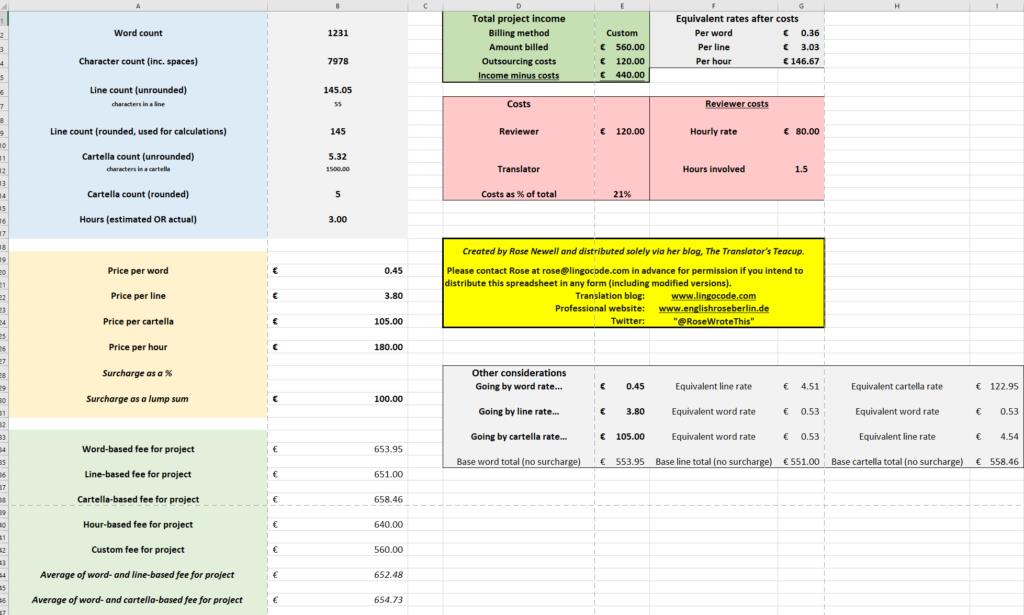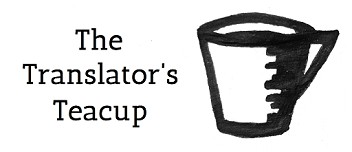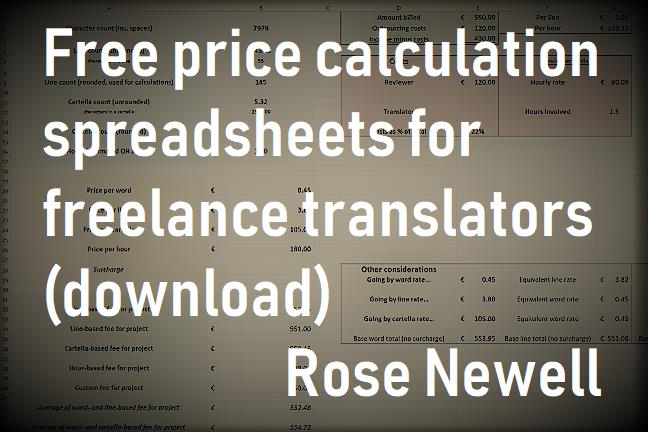As some of you may know, I have quite a bee in my bonnet about proper pricing and strategic positioning when it comes to freelance translation.
Pricing is complicated, and I could easily dedicate an entire blog to the topic. Instead, I would like to share two tools – two different spreadsheets for calculating translation fees. One allows you to calculate a rate while comparing different pricing methods (per word, per line, or per cartella), while the other allows you to easily calculate the correct fee for any projects where you are granting a match discount (most commonly for agencies).
Note that I almost always quote a project fee to my translation clients, but this is usually a round number based on whatever my spreadsheet spits out in terms of per line (primary) and per word (secondary) rates, with a little lee-way either side depending on any additional work that may or may not be involved. Obviously, all the figures stated are just examples to help it make it clearer to you how the numbers fit together.
The first perhaps requires a little explanation of what the different methods are for those outside Europe, and why I like to take multiple methods (in my case, words and lines) into account:
Different pricing methods
Per word
Per word is the most common pricing method in the US, UK, and many other areas.
Advantages:
- Easy for most people to get their heads around.
- Self-explanatory for many languages, such as English or Spanish, that don’t create monster words.
Disadvantages:
- Very small unit, so effectively commoditises the service by default. Brits get around this slightly by quoting rates per 1,000 words to clients.
- Can be particularly disadvantageous for more complex texts, as it essentially renders all words – even short and long ones – equal.
- Can be outright dangerous for texts or source languages that contain many compound words, as these all count as one word.
- In certain languages, such as German, it essentially penalises clients who write well – by charging them more for avoiding monster words and writing content that is easier to digest.
Per line
Per line is arguably the most common pricing method in Germany, Switzerland and Austria, at least among more established or upmarket translators. Nowadays, this has to do with the last disadvantage listed above. While many colleagues calculate based on the source line today, it used to be more common to calculate based on the target. This was great in the days of typewriters, when the length of documents could not always be easily calculated in advance. These days it is less desirable, as the translator and their client has no idea what the cost will be until they are finished, and it encourages wordiness.
Advantages:
- Per line does not penalise good writers who favour short words over long ones.
- Colleagues report this method tends to be more consistent in terms of workload across different clients, styles, authors, and types of text.
- Larger quantity of text than just one word, so less commoditising down to the smallest element.
Disadvantages:
- Harder for people to get their heads around (how many characters? are spaces included?).
- Unnecessarily complicated for languages that do not create monster words.
Per cartella (or page, or similar)
Per cartella or page rates are commonly used in literary translation, Italy, and some other settings. I am not as informed on this pricing method. I’m going to skip the advantages and disadvantages, as I do not really know enough to comment. There is obviously some overlap with per-line rates in terms of how it is calculated, though.
Spreadsheet 1: Comparing pricing methods

I use a variation on this tool every day to help me calculate my rates effectively and fairly, keep a record of what I am charging to which clients, and track the profitability of individual jobs. I have different tabs for each of my most regular clients, so can easily see at a glance how I tend to price things for that client. I just copy one of the tables each time and rename it to match the name of each client.
I usually look at both the per-word and the per-line rate, favouring the output of the per-line rate. I am more inclined to charge a higher rate if I notice the usual per-word rate is much lower than the per-line rate (this suggests the text is wordy – with more characters per word), and more inclined to charge a lower rate if I notice the per-word rate is much higher than usual (this suggests the text is well written – with fewer characters per word). I always examine the text concerned and tweak the rate up or down, sometimes adding a flat fee or percentage-based surcharge.
It may not be the clearest spreadsheet in the world, but it works well for me, and includes a lot of supplementary information I find useful when I am trying to figure out how to price something.
Download the spreadsheet for comparing pricing methods
Spreadsheet 2: Agency fee calculator (with match discounts)

While I stopped working with translation agencies for a variety of reasons many years ago, I still remember and get wind of how they operate. A common issue you see translators complaining about or at least questioning is how agencies calculate their match discounts. Sometimes agencies make mistakes – just like translators do. And sometimes things are skewed against translators by design.
I want to focus just on the tools in this post, but still feel obliged to mention a few points in relation to match discounts:
- Agencies often expect match discounts for an existing TM you did not create. Those matches may be very poor quality, so why should these segments be discounted?
- If you complain about the quality of matches, agencies may say it is okay to edit them. What, for free?
- If the agency does not allow you to change those segments, but you are still expected to spend time referring to them for consistency with potentially iffy terminology, this will cost you time.
- Anything below 85% is usually unusable.
- Anything below 95% may still be largely unusable.
- The way SDL Studio defines a match appears to have been changed recently, to the benefit of agencies rather than translators.
- The way matches are defined can vary greatly between tools.
Nevertheless, this is the reality of the translation profession – many translators work with agencies, and many agencies demand match discounts.
I created this tool after a friend of mine had a problem with a client: she had been provided one analysis and total fee, but her own analysis was very different. I created this spreadsheet for her so she could check her own maths easily and visually, and report her findings to the agency.
As my friend was also using an analysis from SDL Studio, I created this spreadsheet with colour coding to allow for a range of different ways of calculating rates and match discounts. If you have an SDL Studio analysis at hand, you can easily copy and paste this into the tool. Otherwise, you can enter in the values manually using a different section. Just follow the colour coding!
Download the spreadsheet for examining agency fees with match discount tables
To sum things up…
I’ve been meaning to share this post for a little while, so sorry that I kept forgetting about it. What can I say? I’ve had a lot going on, what with obtaining German citizenship, stressing about Brexit, and now buying an apartment in Berlin. Time is in short supply, but maybe these tools will help some of you save some precious time. More importantly, though, I hope they help you to build your understanding of pricing in general, how different pricing methods compare, and the effect match discounts have on your bottom line.
If you have other thoughts on the advantages and disadvantages of different pricing methods, please add these in the comments below! These things vary so much by culture, specialisation, and day of the week. It is impossible for me to sum up everything here, so I and everyone else reading this will be glad to learn from your experience!


Thanks for sharing such useful resource, Rose!
I’m impressed.
How do you count the number of lines in a very long document?
Sorry, I rarely check the comments on here… I count the characters including spaces and divide by 55 – that’s how it’s generally done in my language combination. But I tend to use hourly pricing these days.
Wow Rose, love the calculator and your bio. All the best
Just came across this post by accident, Rose. Excellent info and thanks for sharing!
Thank you so much for this! Very useful spreadsheet!
Wow, that is a very helpful spreadsheet for every freelance translator! Thanks for sharing it.
How can I calculate the cost of a 2 tabs excel spreadsheet?
I have translated word/pdf texts, technical and literary for nearly 40 years and those we can easily calculate by the word count.
That feature is not available in excel. So, please, heeeeelp! Thank you
Sorry for the late response. I would use a CAT tool – that’s one of the big advantages of CAT tools, aside from consistency. I just put it into memoQ and memoQ does the calculations for me… However, you could also just google “word count Excel” – I just did and found a few code-based options. As in, you just type it into a neighbouring cell and Excel will do it.
Thanks for sharing a great resource, Rose!
It looks impressive.
Will use it in my next quotations.
Glad to see a systematic approach to pricing. I’ve noticed a lot of translators seem to have no system of pricing at all, which leads to over and under charging. Translation rates are all over the board, but it give me hope to see movement in the right direction!
Hi Dan!
Whoopsie – only just saw your comment. I’m not sure how systematic or not my approach really is, to be honest – at least as regards others. But using this table certainly makes things easier for me. When I have a new client, I find a client they resemble closely in terms of what they send for translation, copy that tab, and go from there, tweaking as necessary. Not sure how systematic that is, but it works for me. :)
RE: undercharging and overcharging… Yes. But perhaps there are other issues with underselling and overselling going on, too. Discussion for another day!
Hi Rose, I stumbled across your blog when looking for something quite different and am very pleased that I did. The spreadsheets are very useful as I too struggle with the pricing of translations. To be honest, I find the whole idea of a word (or even line or page rate) rather bizarre as it suggests that a translator simply replaces a word in the source language with a corresponding word in the target language. Clearly we do more than this!
In the first spreadsheet, you also calculate an hourly rate but don’t discuss this method of pricing in your post. Do you ever use an hourly rate? Most of my work is actually editing work written in English by non-native writers and I almost always quote them a project price based on estimated number of hours. I’m trying to do this for translations too (Dutch to English = lots of compound words), not always successfully.
Hi Jane!
Sorry for the very slow response. I use an hourly rate for my copywriting and editing work, actually. I also use it for some adaptation and transcreation work where the exact extent of the work is quite unpredictable.
I didn’t discuss it in the post as it’s not really such a controversial subject that needs explaining. IMHO, hourly rates should be set at a rate that matches what you make per hour translating. It should be relatively high, because it also puts people off wasting your time. Unlike many copywriters, I charge an hourly rate. When you’re working with non-native speakers, though, the reason why quickly becomes apparent – I have no control over how long it will take them to understand something, or explaining why something is in fact correct, and so on. :)
Very helpful spreadsheets! thank you!
Thanks, Rose – you can be sure I’ll only be using them for myself.
Great post and solid arguments. Once wrote a price calculator for a print shop, and their calculation is also immensely complicated, while clients only see the end price. I sometimes think commodity pricing is intended to save the client the work of shopping around – and it always backfires, even with conventional commodities. Just think of food. You start valuing that in terms of calories per kilogram and you end up with a shopping cart full of refined flour, sugar and fat – or “machine post-edited food.”
Regarding per-page pricing, the German Normseite is usually defined as 30 lines of up to 60 chars or simply 1500 chars w/o spaces. For German I apply an average word length of 7,5 chars, so that gives me around 200 words per standard page.
For certified translations, however, I use a flat fee per (estimated) target page + rush charges and give clients a round estimate. Official clients may ask you to calculate by standard line, but even a manual count is rarely accurate.
Thank you for this, Rose!
Zehr schön.
Thanks so much for posting this, and for having developed it in the first place.
Thank you!
Thank you very much, Rose, this looks really useful, may I share?
Please, feel free to share the link to this post! I’m just not keen on the idea of some instaguru taking the spreadsheets and sharing them without the explanatory notes or credit to me. :)
Thank you Rose.
Very useful for me.